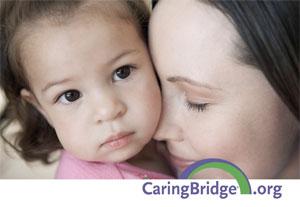Social media and the internet have come to impact virtually every area of life. From business relationships on LinkedIn, to the proliferation of celebrities on Twitter, to the nearly 500 million users of Facebook, we are literally connected with others in every possible way. I recently learned about a touching new social media tool for patients who are critically or terminally ill and their family members and friends. Born out of her own difficulties around a premature delivery and death of her infant child Sona Mehring created “Caring Bridge.” Based in Minnesota, the Caring Bridge organization and committed staff members, provide a simple, but invaluable, service to patients and loved ones of the ill and dying. The Caring Bridge offers individual mini-websites where a patient’s story can be told, along with updates on his or her treatment and condition. The site is interactive, with features for posting photographs, making journal entries, offering tributes and making online donations. Friends and loved ones are encouraged to register on the website in order to enter the cybercircle of support for the person undergoing treatment. Likewise, for those who have chosen to be part of this community, the user will receive automatic emails when the patient or his/her caretakers post an update to the journal. This is a particular tool of social media, for those who are critically ill or dying. Unlike Facebook, it was designed with a singleness of purpose and has greater oversight and management, but encourages full communication and information.
I have a vague recollection of hearing about this service a couple of years ago when reading a Newsweek article where the journalist Jonathan Alter describes his battle with non-Hodgkins Lymphoma. But it was only in the last few weeks that I utilized the service myself. After “finding” a childhood friend on Facebook, I noted that she had listed a caringbridge link as her website. My heart dropped when I noticed that in her profile. I registered for the service and read her site. She and I had grown up together in a small oil town in Oklahoma. As was the case with a number of my friends in school, her family was transferred to Houston, where Conoco Oil Company (now part of Conoco Phillips) had a much larger Operation. She and I were not particularly close friends, but we attended the same grade school, played in a band together, and shared a number of mutual friends. Obviously we had lost touch. I looked at her picture, now decades later, and she looked just the same. She was married to a man for 20 or more years and had three children of middle and high school age. “Her story” indicated that she was diagnosed with brain cancer about three years ago. After a remission that lasted perhaps 9 months, the cancer came back. After a number of new medical protocols at the famed MD Anderson Cancer Center in Houston, one of the finest in the world, her doctors determined that they had run out of viable treatment options. When I logged into her web of support, she had returned home to live out the remainder of her life. Her husband wrote exquisite updates on her journal, that were heartwarming, wise, but, of course, very painful to read. The telling of their story was intertwined with and informed by their deeply held Christian faith. As such, her husband was certain about the divinity of her life’s plan, despite the incredible sadness by which it was accompanied. He was clear about her soul’s ultimate salvation and the fact that his Lord would be with his wife and the rest of his family as she passed. During the last update I received he mentioned that she had been taken to a hospice facility, where presumably the palliative care would be easier to manage. He also described the very thin veil that exists between life and death and that this was clearly a Holy process.
I have thought about my old friend much during the last several weeks, including her in my thoughts and prayers. I have been shaken by the bad hand she has been dealt, but inspired by the love that clearly surrounds her and the principled life she is leading. In the words of professionals in the field, she is experiencing a “good” death, which is the by-product of a well-lived life.
As I think about the service provided by Caring Bridge I am uplifted at how technology is providing some small measure of comfort and convenience for those who want to offer their support to this patient and her family, allowing her husband to ask for what he needs and excusing him from continual rounds of updates with the countless people who care. I trust that the words of encouragement he receives on a daily basis—a far greater volume if his circle of friends did not have this type of tool—will afford a bit of sustenance in the journey. And just this morning, I was thinking that these various notes and tributes will certainly be a cherished reminder to her children, later in life, as they reminisce about her life and the grace and dignity with which she faced death.
I salute Mehring who started this program in 2003, as one coping mechanism for dealing with her own grief, well as the countless staff, volunteers, board members, and contributors who make the Caring Bridge possible. All of these people—most especially my friend and her family—have taught me lessons about giving and receiving love, allowing the inevitability of death to help create and sustain a meaningful life, and of the sheer power of affection and gratitude from near and afar.

